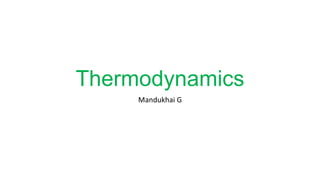
Thermodynamics
- 2. 2𝐴𝑢 + 3𝐻2𝑂 → 𝐴𝑢2 𝑂3 + 3𝐻2 𝑏𝑎𝑙𝑎𝑛𝑐𝑒𝑑 𝑏𝑢𝑡 𝑛𝑜𝑡 𝑜𝑐𝑐𝑢𝑟 Proceed only partially Generating some products but remaining most of the original reactants unchanged The rate of reaction can also be affected by other factors such as temperature In a reaction, it is important to realize that whether oIs energy absorbed or released oFast or slow oDoes reaction continue until all reactants are converted into products or is there a point beyond which no additional products formed.
- 3. Fundamental kinds of energy 1. Potential energy - stored energy (eg. Water in a dam, energy in a coiled spring waiting to be released.) 2. Kinetic energy - Is the energy of motion. (eg. Water falling over a dam, uncoiled spring)
- 4. In chemical compounds, - The attractive force between atoms or ions a kind of potential energy When these attractive force result in the formation of ionic or covalent bonds,] - Potential energy heat ( a kind of kinetic energy) - The strength of a covalent bond is measured by its bond dissociation energy. (the amount of energy that must be supplied to break a bond and separate the atoms in an isolated gas molecule.
- 6. - Breaking of the bonds requires an input of energy. Thus, Bond breaking is an endothermic reaction( a process or reaction that absorbs heat) ∆H is positive Bond making is an exothermic reaction. (a process or reaction that releases heat) ∆H is negative
- 7. Heat of the reaction or Enthalpy change (∆H) - The difference between the energies of bond broken in reactants and the energies of bond formed in products. The sign of ∆H can e either positive or negative. Enthalpy (H) A measure of the amount of energy associated with the substances involved in a reaction.
- 8. Law of conservation of energy Energy can be neither created or destroyed in any physical or chemical change. ∆H =∑(𝑏𝑜𝑛𝑑 𝑑𝑖𝑠𝑠𝑜𝑐𝑖𝑎𝑡𝑖𝑜𝑛 𝑒𝑛𝑒𝑟𝑔𝑦)𝑟𝑒𝑎𝑐𝑡𝑎𝑛𝑡𝑠−∑(𝑏𝑜𝑛𝑑 𝑑𝑖𝑠𝑠𝑜𝑐𝑖𝑎𝑡𝑖𝑜𝑛 𝑒𝑛𝑒𝑟𝑔𝑦)𝑝𝑟𝑜𝑑𝑢𝑐𝑡𝑠 The amount of heat absorbed or released in a reverse of reaction is equal to that released or absorbed in a reverse of reaction, but ∆H has the opposite sign.
- 9. Energy from food 1 Cal = 1000kcal = 1kcal = 4184J
- 10. Why do chemical reactions occur? Entropy (S) Free-energy change ∆G tell us only whether a reaction can occur.
- 11. Spontaneous process: A process or reaction that, once started, proceeds on its own without any external influence. Unspontaneous process: takes place only in the presence of a continuous external influence. (Events that lead to lower energy states tend to occur spontaneously)
- 12. Entropy (S) A measure of the amount of molecular disorder in a system Entropy change (∆S) : A measure of the increase in disorder (∆S=+) or decrease in disorder (∆S= -- ) as a chemical reaction or physical change occurs.
- 13. Free energy change ∆G: A measure of the change in free energy as a chemical reaction or physical change occurs. It determines spontaneity.
- 14. How do chemical reactions occur? Reaction rates G, activation energy, reaction rate How fast the reaction will occur?
- 15. Collision theory Activation energy (Eact ) The amount of energy necessary for reaction to occur; it determines the reaction rate. The sizes of the activation energy determines reaction rate, how fast the reaction occur.
- 16. Effects of Temperature, Concentration and Catalysts on Reaction rates
- 17. Effects Increase in Temperature Increase in frequency of collisions In forcefulness of collisions Increase in reaction rate Increase in concentration Increase in frequency of collisions Increase in reaction rate Add a catalyst Lower activation energy or by orienting the reacting molecules propriately Increase in reaction rate
- 18. Reversible reactions and Chemical Equilibrium
- 19. Reversible reactions: A reaction that can go in either direction, from products to reactants or reactants to products. Chemical equilibrium: A state in which the rates of forward and reverse reactions are the same.
- 20. Equilibrium Equations and equilibrium Constants
- 21. Equilibrium constant (K) : Value obtained at a given temperature from ration of the concentrations of products and reactants, each raised to a power equal to its coefficient in the balanced equation.
- 22. Le Chatelier’s Principle: The effect of changing conditions on Equilibria
- 23. Le chatelier’s principle: When a stress is applied to a system at equilibrium, equilibrium shifts to relieve the stress
- 24. Regulation of body temperature Hypothermiaslowing body reactionsenergy production drop-death +cardiac surgery Hyperthermiaaccelerating reactionsspeed up pumps-stroke